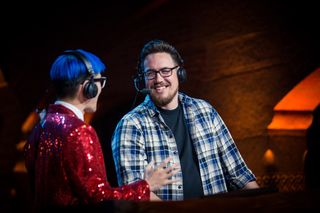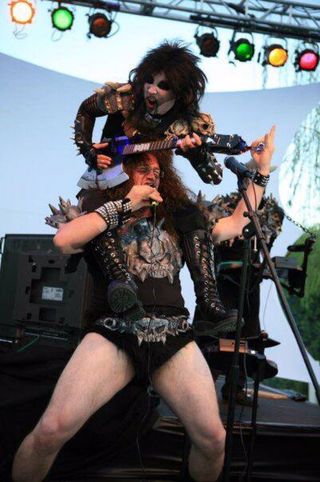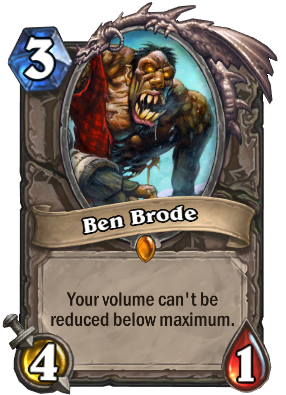The unstoppable rise of Hearthstone's Ben Brode
From pizza slinger to the brains and voice of Blizzard's CCG behemoth.

It's almost frightening when Ben Brode laughs. It is a subterranean, multi-decibel, overpowering noise. A sharp inhale followed by a barrage of cackles that demolishes any empty space between freshly-minted acquaintances. You feel the bass in your chest. The coffee mugs on the table tremble like a T. Rex is stomping through the jungle canopy. How the hell did this man, this ridiculous, gigantic man, choose a children's card game to make his career? He should be leading troops through the breach, or teaching trembling grade-schoolers how to snare a rabbit. He should be on-stage with Outkast, or rather, Outkast should be onstage with him.
It's an early Sunday morning in Amsterdam, the fourth and final day of the Hearthstone World Championship, and I'm nursing a grainy hangover with a blend of buffet-grade breakfast meats. Across from me is The Brode. Immaculate, untouched, in one of his perfectly ironed flannel shirts and a springy plume of caramel hair that makes him look part mad scientist, part Paul Bunyan. He tells me that 15 years ago, when he was just getting his feet wet at Blizzard, he worked part-time at an Italian joint called Gino's Pizza. "I still go back there, and when I walk in the door the guy who owns it goes 'HAHAHA.'" says Brode. The legend was already alive and well, we just didn't know it yet.
Nominally, Ben Brode is the game director of Hearthstone. He goes to work everyday to think about the flavor, balance, and presentation of Blizzard's ludicrously popular CCG. Next month he'll unveil the team's 11th expansion, and perhaps more crucially, the cards they're exiling into the Hall of Fame—essentially Hearthstone's memory hole. It's the sort of swerve that could destroy years' worth of hard-earned goodwill. The men and women behind the curtains are all hanging by a thread, agonizing over every decision.
Frankly, the notion of any celebrity emerging from those slag mines and server bays ought to be laughable. Why should a computer programmer run the front of house when you've got Thrall, Jaina, and Sylvanas waiting in the wings? Why would anyone want to be reminded that the source of all that wonderment and world-building, all those chiseled digital deltoids, is a bunch of escapist dorks just like us?
But Ben Brode is different. Ben Brode is now Ben Brode, professionally. He still gets in the tank with his colleagues, he's still forced to make tough, unpopular choices, but he's also recorded an awesomely terrible rap about Un'goro Crater from his home desktop. He's cosplayed as a Ny'alotha cultist to talk about C'Thun. He's laughed his ass off as the then-unannounced Bloodreaver Gul'dan was burned by Brian Kibler live on stream (above).
Earlier this week I watched him play Hearthstone charades with a small collective of influencers on stage at a pop-up Amsterdam tavern, and about 12 hours after our talk, he'll snap a goofy selfie with the newly-crowned World Champion Tom60229 (below).
The Champ!! pic.twitter.com/q9P8r59gf0January 21, 2018
Brode, of course, is a talented designer, but his most useful asset might be his ability as a performer—how his impeccable charisma now ties this community together, when in the past it seemed perpetually on the verge of civil war. Blizzard is uniquely fortunate that one of their best soldiers has emerged as an adored personality through pure, grassroots momentum—especially considering just how radical that concept was to games industry culture a few years ago.
The biggest gaming news, reviews and hardware deals
Keep up to date with the most important stories and the best deals, as picked by the PC Gamer team.
There weren't very many people at Blizzard who had this role. There's Metzen and Morhaime, but we've been pretty conservative about it.
"There weren't very many people at Blizzard who had this role. There's Metzen and Morhaime, but we've been pretty conservative about it," says Brode. "We were supposed to be speaking with the 'company voice.' Press releases without individuals, 'the Blizzard statement.' That was how things were for many years. I knew the Hearthstone team was different when, just before we announced the game, someone on the social side of things asked me what my Twitter handle was to tag me in some pictures. I had never used Twitter before. I created one for that event, and I asked the production director at the time if I was allowed to tweet, and he said 'do whatever you want.' ... It was a complete change for me."
Ranking up
Brode was named Hearthstone's lead designer in late 2015, at the dawn of the Whispers of the Old Gods cycle. Later that year he was promoted again, this time to game director. That was the culmination of a professional journey that had begun in the bowels of the Irvine offices, where he held down the 9pm to 4am graveyard shift testing Warcraft III. Brode calls that period of his life "super fun"—the night crew routinely wasted hours after they got off the clock bullshitting in front of the office until the sun came up. In all, his testing career spanned about 18 months—the lion's share of which was spent working on World of Warcraft as part of a cabal of bug-smashers called the "cheese team," who specifically targeted lingering exploits baked into the netcode.
Eventually, Brode moved to the day shift, (but specifically requested to work 1pm to 10pm, so he could still hang out with his overnight grognards), and was made an "Environment Test Lead," which is essentially Blizzard speak for company-mandated Sisyphean torture. Every day and night, Brode ran his characters into all the surfaces in Azeroth to make sure that they weren't accidentally made of jelly. That he somehow looks back on the job fondly is either a testament to Blizzard's incredibly strong workplace culture, or proof that they're piping too much fluoride into the water fountains.
Brode remembers that failure as one of the most important moments of his life...
Generally, there's not a lot of room for creativity when you're spending entire afternoons identifying texture errors, but Brode's first steps as an honest-to-god game designer dovetailed neatly with his testing career. He was tasked with identifying the kinks in the Warcraft III level editor for Macintosh, which forced him to make a ton of maps. Brode had poured his adolescence into the right angles and working toilets of Duke Nukem 3D, and relished the artisanal pleasure that comes with crafting a devious, perfectly-tuned battlefield. Warcraft was no different, and Brode got good.
"I made a couple maps that got pretty popular," he says. "I made this one called Worm War, and I sent it off to the Warcraft III team, they loved it and made it a 'Map of the Week'—back when they were releasing maps every week from Blizzard."

From there, Brode's climb continued by knocking on every door in the office. He secured an interview for a development position on StarCraft II, and drew a world-stopping blank when one of the project leads asked him how he'd improve the RTSes he was currently playing. "I had never thought about it like that before. I was just playing and enjoying this game. I said something like 'I don't know, make the tutorial better?' It was the least satisfying answer ever," remembers Brode. Needless to say he didn't get the job, and today Brode remembers that failure as one of the most important moments of his life—the first time he recognized the fundamental responsibilities of game design.
Instead, Brode worked in creative development on the underrated World of Warcraft Trading Card Game, which itself pioneered a number of the concepts and mechanics that later found their way into Hearthstone. It was there that he came face to face with the occasionally obstinate corporate culture at Blizzard; he recalls declining several interview requests out of hand, simply because there wasn't precedent for the kind of candid, one-on-one interaction with the press he wanted to have.
In retrospect, it's a shame that those sort of encounters were so feared, because Brode is a natural. This company managed to hire someone who was passionate about beatboxing and strong turn-two counterplays, and it wasn't until Team Five started working on Hearthstone in earnest that they realized what an advantage having that kind of character could be.
Bright-eyed scout leader
Brode credits his stage presence to his time running a boy scout caravansary in Marina Del Rey. If you spent your preteen years screwing up esoteric knots, you know what he's talking about; quick, one-shot pantomimes improvised in front of a dusky swirl of campfire embers and s'more crumbs.

Brode takes to the stage in 2009 as part of a Guitar Hero competition.
It makes sense, really. Brode might be encumbered with numerous administrative responsibilities, but when he interacts with the Hearthstone community, (who are generally at least a decade his junior,) he joyfully reprises his camp counselor role. Sure he might not be teaching the younglings how to treat poison oak, but he is wisecracking about Corridor Creeper and recruiting interns over Twitter. "I often say my greatest joy is having a microphone," laughs Brode, who also fills in as the stage announcer for BlizzCon’s opening ceremonies. "I've always loved it."
He continues to put that microphone to good use. One of the longest standing complaints in the Hearthstone community is the idea that the development team does a poor job of communicating their thought processes to the player-base. This is dubiously valid: These days both Brode and principal game designer Mike Donais are regularly active on Reddit, and Christina "Zeriyah" Sims does an excellent job translating card interactions on Twitter.
However, when compared to the weekly tunings churned out by the Heroes of the Storm balance team, and the custodial work put in by Jeff Kaplan on the Overwatch YouTube channel, I can understand why some people petition the Hearthstone brass for a more consistent flow of information.
It's funny how people will trust you if you're simply willing to be a human being.
Brode is aware of this. One of his favorite things he's done in the community was a spur-of-the-moment response to a video by mega-streamer Octavian "Kripparrian" Morosan. Kripp argued for more active, reactive buffs to old, underpowered cards. Brode was watching the soliloquy in his bedroom, and wanted to say his piece in response.
"His platform was much more powerful than any of our current platforms. He talked very directly and passionately to the camera, and he's very convincing," recalls Brode. "I was like, 'How could I respond to this?' I could tweet something. I could make a post about it. But I don't have the ability to engage in the same way that he does. I was sitting in my bedroom, and I recorded a video explaining some of the downsides to buffing cards. I sent it to our community team the next morning, and they sent it directly to Kripp."
Brode's response was posted to Kripp's YouTube channel in the summer of 2015. It broke all the rules—here was a Blizzard employee speaking freely about his design philosophy through the platform of one of their prime influencers—but it worked surprisingly well. The thing Brode emphasizes again and again is that, at the end of the day, he is a massive fan of Hearthstone, and he roots for this game in the same way that we do. What better way to demonstrate that than by handing off editorial control to an outside presence?

All Hearthstone devs get their own custom card. This is the big man's.
Brode, of course, still has a target on his back. As the face of the game, he's the conduit for a ton of admiration, and a ton of complaints. Hearthstone fans are volatile, and he feels that most of that anger can be quelled with better top-down communication. "It's a critical source of input for us," he says, when I ask if the negativity in this player-base ever gets to him. "It's an opportunity to explain things to our audience."
Still, there are times when that communication falls short. He's entirely aware that in late 2017, he told the community that the team was evaluating the ranked play experience, and to expect a more fleshed-out update before the end of the year. Last week the team announced those tweaks, but they missed their self-imposed deadline, and Brode sometimes wonders if he should've said anything at all.
"We try now to say, 'Hey here's what's going on, here's what's up, here's our philosophy.' But there's some risk. The more we communicate, the less announcements we have. When we fill that gap with more, 'This is how we feel,' there are less times where we get to say, 'Here's this new thing we're implementing,'" he explains. "There's a real danger there. We said we we're going to accept that danger, and our communication is going to be less satisfying to a certain degree. Because it just can't always be, 'Here's the action plan for your feedback.'"
Still, it's undeniable that Brode has figured out a blueprint that works in 2018. He has shaken off Blizzard's fears of looking too silly or being too candid, and he will never again be defined by bloodless press releases. Brode has blended his lessons from the log cabin and the server bay to become something brand new, and now he's distinctively capable of handling the heat and scrutiny that comes with managing 70 million players. It's funny how people will trust you if you're simply willing to be a human being. Every games company in the industry wants to have their very own Ben Brode, and trust me, they're looking.

Luke Winkie is a freelance journalist and contributor to many publications, including PC Gamer, The New York Times, Gawker, Slate, and Mel Magazine. In between bouts of writing about Hearthstone, World of Warcraft and Twitch culture here on PC Gamer, Luke also publishes the newsletter On Posting. As a self-described "chronic poster," Luke has "spent hours deep-scrolling through surreptitious Likes tabs to uncover the root of intra-publication beef and broken down quote-tweet animosity like it’s Super Bowl tape." When he graduated from journalism school, he had no idea how bad it was going to get.
Most Popular


